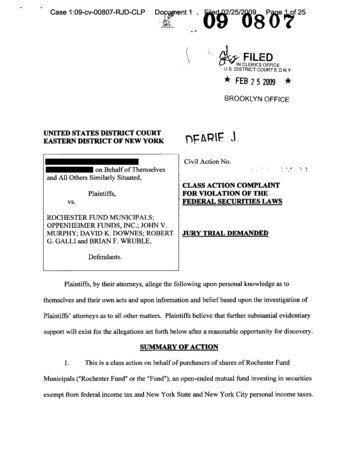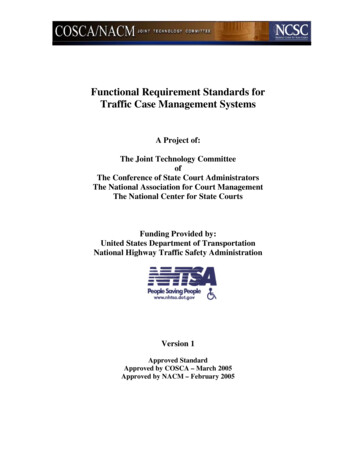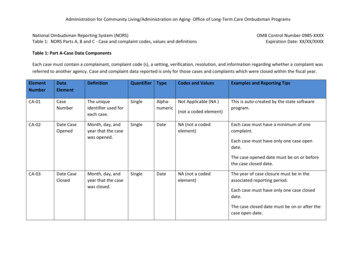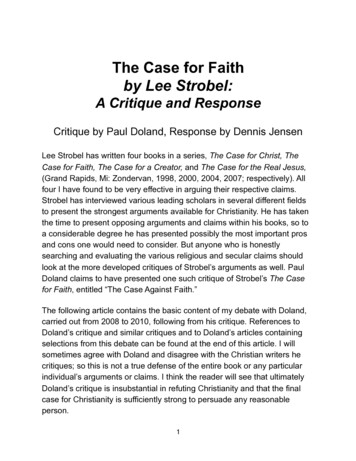
Transcription
j Case 1:09-cv-00807-RJD-CLP Document 1Filed 02/25/2009 Peag 1 of 254Jeffrey S. AbrahamJack G. FruchterLawrence D. LevitFILEDiIN CLERK'S OFFICEU S. DISTRICT COURT E.D.N YABRAHAM, FRUCHTER & TWERSKY, LLPOne Penn Plaza, Suite 2505New York, New York 10119Tel: (212) 279 -5054Fax: (212) 279 -3655FEB 2 5 2009BROOKLYN OFFICEAttorneys for Plaintiffs Lisl Bernstein and Todd Augenbaum.UNITED STATES DISTRICT COURTEASTERN DISTRICT OF NEW YORKLISL BERNSTEIN and TODDAUGENBAUM, on Behalf of Themselvesand All Others Similarly Situated,Plaintiffs,VS.Civil Action No.CLASS ACTION COMPLAINTFOR VIOLATION OF THEFEDERAL SECURITIES LAWSROCHESTER FUND MUNICIPALS;OPPENHEIMER FUNDS, INC.; JOHN V.MURPHY; DAVID K. DOWNES; ROBERT JURY TRIAL DEMANDEDG. GALLI and BRIAN F. WRUBLE,Defendants.Plaintiffs, by their attorneys, allege the following upon personal knowledge as tothemselves and their own acts and upon information and belief based upon the investigation ofPlaintiffs' attorneys as to all other matters. Plaintiffs believe that further substantial evidentiarysupport will exist for the allegations set forth below after a reasonable opportunity for discovery.SUMMARY OF ACTION1.This is a class action on behalf of purchasers of shares of Rochester FundMunicipals ("Rochester Fund" or the "Fund"), an open-ended mutual fund investing in securitiesexempt from federal income tax and New York State and New York City personal income taxes.
Case 1:09-cv-00807-RJD-CLP Document 12.Filed 02/25/2009 Page 2 of 25The Fund employed strategies which enhanced its reported returns while, at thesame time, exposing the Fund to a greater risk of price declines in the value of its portfoliosecurities in the event of any illiquidity in the market for municipal securities. However, indoing so, the prospectuses and other sales materials employed in selling and marketing the Fundfailed to disclose that these very strategies exposed the Fund to substantially greater risk of lossdue to Rochester Fund being forced to sell large blocks of portfolio securities at disadvantageoustimes and prices reduced from those which the securities were previously carried on RochesterFund's books.3.These undisclosed risks were first disclosed in a prospectus supplement datedOctober 21, 2008 (the "Prospectus Supplement") and followed a precipitous decline in the valueof the Fund's shares which materially exceeded the decline in value experienced by a peer groupof municipal bond funds which did not employ the same risky strategies employed by RochesterFund.4.Plaintiffs purchased shares of the Fund issued pursuant to a prospectus whichfailed to disclose the relevant risk factors, which resulted in this financial loss, and is bringingthis action on her behalf and on behalf of a class (the "Class") of similarly situated investors torecover damages.JURISDICTION AND VENUE5.The claims asserted herein arise under Sections 11, 12(a)(2) and 15 of theSecurities Act of 1933 (the "Securities Act" or the "1933 Act"), 15 U.S.C. §§77k, 771(a)(2) and77o. Jurisdiction is conferred by Section 22 of the Securities Act, 15 U.S.C. §77v. Venue is2
Case 1:09-cv-00807-RJD-CLP Document 1Filed 02/25/2009 Page 3 of 25proper pursuant to Section 22 of the Securities Act as key defendants maintain their principalexecutive offices in New York and Plaintiffs reside in this District.PARTIES6.Plaintiffs Lisl Bernstein and Todd Augcnbaum purchased shares of the Fund asdetailed in the attached Certifications and were damaged thereby.7.Defendant Rochester Fund located at 350 Linden Oaks. Rochester, New York14625 is a diversified mutual fund which seeks to provide a high level of income exempt fromfederal income tax as well as New York State and New York City income taxes. Rochester Fundhas more than 9 billion under management and its shares are offered in four separate classes:Class A Shares requiring the payment of an initial sales charge; Class B Shares on which noinitial sales charge is paid at the time of purchase, but requiring a contingent deferred salescharge if the shares are sold within 6 years of buying them; Class C Shares on which no initialsales charge is paid, but requiring the payment of an annual asset-based sales charge and thepayment of 1.0% sales charge if sold within 12 months of buying them; and Class Y Shareswhich are offered pursuant to special arrangements.8.Defendant Oppenheimer Funds, Inc. (Oppenheimer"), located at Two WorldFinancial Center, 225 Liberty Street, I V h Floor, New York, NewYork 10281, is the Fund'smanager and is responsible for choosing the Fund's investments and handling its day-to-daybusiness. Oppenheimer earns an advisory fee calculated based on the net assets of the Fund andthose fees for the calendar year ended December 31, 2007, was 0.46% of average net assetsunder management which amounted to approximately 45 million.3
Case 1:09-cv-00807-RJD-CLP Document 19.Filed 02/25/2009 Page 4 of 25Defendant John V. Murphy ("Murphy") is a Trustee of the Fund and is also theChairman, Chief Executive Officer and a Director of Oppenheimer.10.Defendant David K. Downes ("Downes") has been a Trustee of the Fund since2005 and oversees 67 portfolios in the Oppenheimer Funds complex.11.Defendant Robert G. Galli ("Galli") has been a Trustee of the Fund since 1998and oversees 67 portfolios in the Oppenheimer Funds complex.12.Defendant Brian F. Wruble ("Wruble") has been a Trustee of the Fund since 2001and oversees 67 portfolios in the Oppenheimer Funds complex. Messrs. Downs, Gall andWruble also serve on the Boards of over 60 Oppenheimer funds. Murphy, Downes, GalIi andWruble are hereafter referred to as the "Individual Defendants."CLASS ACTION ALLEGATIONS13.Plaintiffs bring this action as a class action pursuant to Rule 23(a) and (b)(3) ofthe Federal Rules of Civil Procedure on behalf of a class consisting of all persons who purchasedthe Class A Shares, Class B Shares and Class C Shares of the Fund from February 26, 2006through October 21, 2008 (the "Class Period") and were damaged thereby, excluding Defendants,the officers and directors of the Fund, members of the Defendants' immediate families and theDefendants' legal representatives, heirs, successors, and assigns, and any entity in which any ofthe Defendants have or had a controlling interest or unique contractual arrangement.14.Members of the Class are so numerous that joinder of all members isimpracticable. Although the exact number of Class members is unknown to Plaintiffs at thistime and can only be ascertained through appropriate discovery, based upon the size of the Fundbeing greater than 9 billion, it is likely that there are thousands or tens of thousands of Class4
Case 1:09-cv-00807-RJD-CLP Document 1Filed 02/25/2009 Page 5 of 25members. Members of the Class may be identified from records maintained by Rochester Fund,Oppenheimer or their agents, and may be notified of the pendency of this action by mail, using aform of notice similar to that customarily used in securities class actions.15.Plaintiffs' claims are typical of the claims of the other members of the Class.Plaintiff and the other members of the Class have sustained damages because of Defendants'unlawful activities alleged herein. Plaintiffs have retained counsel competent and experienced inclass and securities litigation and intend to prosecute this action vigorously. The interests of theClass will be fairly and adequately protected by the Plaintiffs. The Plaintiffs have no interestswhich are contrary to or in conflict with those of the Class that Plaintiffs seek to represent.16.A class action is superior to all other available methods for the fair and efficientadjudication of this controversy. Plaintiffs know of no difficulty to be encountered in themanagement of this action that would preclude its maintenance as a class action.17.Common questions of law and fact exist as to all members of the Class andpredominate over any questions solely affecting individual members of the Class. Among thequestions of law and fact common to the Class are:(a) whether the federal securities laws were violated by Defendants' acts as allegedherein;(b) whether Defendants misstated and/or omitted to state material facts in their publicstatements; and(c) whether the members of the Class have sustained damages as a result of Defendants'conduct and the proper measure of such damages.5
Case 1:09-cv-00807-RJD-CLP Document 1Filed 02/25/2009 Page 6 of 25SUBSTANTIVE ALLEGATIONS18.New York City and New York State have relatively high rates of local incometaxes. In addition, many wage earners subject to high marginal Federal tax rates reside in NewYork. This has made investing in municipal bonds exempt from federal, state and local taxes,popularly referred to as triple tax free bonds, a popular investment alternative for many NewYork residents.19.New York residents seeking to invest in triple tax free bonds have a relativelywide variety of investment options. They can purchase bonds directly or they can buy shares ofmutual funds which invest in those bonds. The mutual funds, in turn, can be either closed-endfunds or open-end funds. Closed-end funds generally have a fixed number of shares which tradeon a stock exchange like regular stocks. The price an investor pays for those funds can be eithergreater, less than or equal to their net asset value ("NAV"), i.e., the total recorded value of theassets owned by the fund divided by the number of shares outstanding. In contrast, open-endfunds continuously offer their shares for sale to members of the investing public generallypursuant to prospectuses which are filed as part of registration statements with the Securities andExchange Commission ("SEC") and, at the same time, generally offer to redeem or buy backthose shares at the same quoted NAV.20.Rochester Fund is an open-ended mutual fund and one of the largest such mutualfunds specializing in New York triple tax free investments. The Fund is sold through anextensive network of financial advisers compensated based upon sales commission and/or assetmanagement fees.6
Case 1:09-cv-00807-RJD-CLP Document 121.Filed 02/25/2009 Page 7 of 25Rochester Fund has been able to successfully compete within this arena and growto become a multi-billion dollar fund because of its reporting superior historical returns. Thesesuperior returns were, in turn, largely generated by the Fund investing as much as 20% of itsassets in derivative securities known as "inverse floaters" which are derivative instruments thatpay interest at rates that move in the opposite direction of yields on short-term securities.22.Inverse floaters, such as those employed by the Fund, are generally created bydepositing a long-term bond into a trust which is used to provide collateral for short termsecurities issued based upon the security of the long-term instrument. Short-term municipalbond rates are lower than the long term rates earned on the underlying instrument which servesas the basis for creating the trust. This allows for a leveraged or increased return to the Fundwhich created the trust.23.Under inverse floater agreements, if the remarketing agent that offers the short-term security is unable to sell them, or if the holders tender (or put) them for repayment ofprincipal and the remarketing agent is unable to remarket them, the remarketing agent may causethe trust to be collapsed and the Fund is then required to repay the principal amount of thetendered securities. In order to do so, the Fund must, i.e., it is forced, sell securities from itsportfolio regardless of market conditions.24.These collapses of inverse floaters forced the Fund's hand to rapidly sell largeblocks of securities held in its portfolio in order to make good on its contractual obligations. Inorder to accomplish these sales and provide the liquidity necessary to honor the Fund'scontractual obligations under the inverse floater agreements, Rochester Fund was forced toaccept prices far below the values at which the bonds were carried on its books.7
Case 1:09-cv-00807-RJD-CLP Document 125.Filed 02/25/2009 Page 8 of 25This was a risk factor which was always present wherever inverse floaters wereemployed. However, no disclosure was made in any of the prospectuses filed as part ofregistration statements with respect to the sale of the Fund's shares.26.Instead, under the general risk disclosures relating to derivative investments, thefollowing risks were disclosed:RISKS OF DERIVATIVE INVESTMENTS. The Fund can use derivatives toseek increased returns.In general terms, a derivative investment is an investment contract whosevalue depends on (or is derived from) the value of an underlying asset, interestrate or index. Covered call options, "inverse floaters" and floating rate variablerate obligations are examples of derivatives the Fund can use. The Fund typicallydoes not use hedging instruments, such as options, to hedge investment risks.If the issuer of the derivative investment does not pay the amount due, theFund can lose money on its investment. Also, the underlying security orinvestment on which the derivative is based, and the derivative itself, might notperform the way the Manager expected it to perform. If that happens, the Fundwill get less income than expected or its hedge might be unsuccessful, and itsshare prices could fall. The Fund has limits on the amount of particular types ofderivatives it can hold. However, using derivatives can increase the volatility ofthe Fund's share prices and can cause the Fund to lose money on its investments.Some derivatives may be illiquid, making it difficult for the Fund to sell themquickly at an acceptable price.27.Specific risks associated with Inverse Floaters were further described inthe April 29, 2008 prospectus as follows:Inverse Floaters. The Fund may invest up to 20% of its total assets (whichincludes the effects of leverage) in "inverse floaters" to seek greater income andtotal return. An inverse floater typically is a derivative instrument created by atrust that divides a fixed-rate municipal security into two securities: a short-termtax free floating rate security and a long-term tax free floating rate security (theinverse floater) that pays interest at rates that move in the opposite direction of theyield on the short-term floating rate security. As short-term interest rates rise,inverse floaters produce less current income (and, in extreme cases, may pay no8
Case 1:09-cv-00807-RJD-CLP Document 1Filed 02/25/2009 Page 9 of 25income) and as short-term interest rates fall, inverse floaters produce more currentincome.Certain inverse floaters are created when the Fund purchases a fixed-ratemunicipal bond and subsequently transfers it to a broker-dealer (the sponsor). Thesponsor deposits the municipal security into a trust. The trust creates the inversefloater pursuant to an arrangement that enables the Fund to withdraw theunderlying bond to collapse the inverse floater (upon the payment of the value ofthe short-term security and certain costs). Additionally, the Fund purchasesinverse floaters created by municipal issuers directly or by other partiesdepositing securities into a sponsored trust.The Fund's investments in inverse floaters may involve additional risks. Themarket value of inverse floaters can be more volatile than that of a conventionalfixed-rate bond having similar credit quality, redemption provisions and maturity.Typically, inverse floaters tend to underperform fixed rate bonds in a rising longterm interest rate environment, but tend to outperform fixed rate bonds in a fallingor stable long-term interest rate environment. Inverse floaters all entail somedegree of leverage. An inverse floater that has a higher degree of leverage usuallyis more volatile with respect to its price and income than an inverse floater thathas a lower degree of leverage. Some inverse floaters have a "cap," so that ifinterest rates rise above the "cap," the security pays additional interest income. Ifrates do not rise above the "cap," the Fund will have paid an additional amountfor a feature that proved worthless.28.The actual relevant risk associated with Inverse Floaters was not discloseduntil the filing of a Prospectus Supplement on October 21, 2008 which replaced existingInverse Floater disclosures with the following:Inverse FloatersThe Fund may invest in inverse floaters to seek greater income and totalreturn. The Fund will not expose more than 20% of its total assets to the effects ofleverage from its investments in inverse floaters. An inverse floater is a derivativeinstrument, typically created by a trust that divides a fixed-rate municipal securityinto two securities: a short-term tax exempt floating rate security (sometimesreferred to as a "tender option bond") and a long-term tax exempt floating ratesecurity (referred to as a "residual certificate" or "inverse floater") that paysinterest at rates that move in the opposite direction of the yield on the short-term9
Case 1:09-cv-00807-RJD-CLP Document 1Filed 02/25/2009 Page 10 of 25floating rate security. The purchaser of a "tender option bond" has the right totender the security periodically for repayment of the principal value. As shortterm interest rates rise, inverse floaters produce less current income (and, inextreme cases, may pay no income) and as short-term interest rates fall, inversefloaters produce more current income.To facilitate the creation of inverse floaters, the Fund may purchase a fixedrate municipal security and subsequently transfer it to a broker-dealer (thesponsor), which deposits the municipal security in a trust. The trust issues theresidual certificates and short-term floating rate securities. The trust documentsenable the Fund to withdraw the underlying bond to unwind or "collapse" thetrust (upon tendering the residual certificate and paying the value of the shortterm bonds and certain other costs). The Fund may also purchase inverse floaterscreated by municipal issuers directly or by other parties that have depositedmunicipal bonds into a sponsored trust.The Funds investments in inverse floaters involve certain risks. The marketvalue of an inverse floater residual certificate can be more volatile than that of aconventional fixed-rate bond having similar credit quality, maturity andredemption provisions. Typically, inverse floater residual certificates tend tounderperform fixed rate bonds when long-term interest rates are rising but tend tooutperform fixed rate bonds when long-term interest rates are stable or falling.Inverse floater residual certificates entail a degree of leverage because the trustissues short-term securities in a ratio to the residual certificates with theunderlying long-term bond providing collateral for the obligation to pay theprincipal value of the short-term securities if and when they are tendered. If theFund has created the inverse floater by depositing a long-term bond into a trust, itmay be required to provide additional collateral for the short-term securities if thevalue of the underlying bond deposited in the trust falls.An inverse floater that has a higher degree of leverage is typically morevolatile with respect to its price and income than an inverse floater having a lowerdegree of leverage. Under inverse floater arrangements, if the remarketingagent that offers the short-term securities for sale is unable to sell them, or ifthe holders tender (or put) them for repayment of principal and theremarketing agent is unable to remarket them, the remarketing agent maycause the trust to be collapsed, and in the case of floaters created by theFund, the Fund will then be required to repay the principal amount of thetendered securities. During times of market volatility, illiquidity oruncertainty, the Fund could be required to sell other portfolio holdings at adisadvantageous time to raise cash to meet that obligation.Some inverse floaters may have a "cap," so that if interest rates rise above thecap, the security pays additional interest income. If rates do not rise above thecap, the Fund will have paid an additional amount for that feature that has provedworthless. (Emphasis added).10
Case 1:09-cv-00807-RJD-CLP Document 129.Filed 02/25/2009 Page 11 of 25The prospectuses initially generally disclosed that some derivatives may beilliquid and the Fund may have difficulty selling them quickly at acceptable prices, i.e., the Fundmay have to hold the Inverse Floaters until maturity or sell them slowly over time. However,another undisclosed material risk of investing in Inverse Floaters was that the owners of theshort-term securities sold by the trust created for the purposes of issuing Inverse Floaters couldeffectively collapse the trusts and require the underlying securities to be sold immediatelyforcing the sale of portfolio securities at disadvantageous times and prices.30.These conditions caused a sharp decline in the value of the Fund's shares. Thus,the NAV of the Class B Shares declined from a closing price of 14.41 per share on October 7,2008 to close at 12.18 per share on October 17, 2008, a decline of more than 15%, an unusuallyhigh decline and far exceeding decline of competing New York municipal bond funds which didnot employ derivative instruments such as the inverse floaters utilized by the Fund.COUNTViolations of Section 1 I. of the Securities ActAgainst Defendants Rochester Fund and the Individual Defendants31.Plaintiffs repeat and reallege each and every allegation above as if set forthfully herein. This Count is brought pursuant to Section 11 of the Securities Act, 15 U.S.C. §77k,against Defendants Rochester Fund and the Individual Defendants. This claim is not based onand does not sound in fraud.32.This claim is brought by Plaintiffs on their own behalf and on behalf of othermembers of the Class who acquired Fund shares pursuant to prospectuses dated: (a) April 29,2005; supplemented on February 8, 2006; (b) April 30, 2006, supplemented on April 30, 2006,11
Case 1:09-cv-00807-RJD-CLP Document 1Filed 02/25/2009 Page 12 of 25July 26, 2006, January 19, 2007 and January 23, 2007; (c) February 21, 2007, supplemented onFebruary 21, 2007, July 6, 2007, August 31, 2007, September 13, 2007, October 22, 2007,December 19, 2007, December 28, 2007 and January 22, 2008, and; (d) April 29, 2008,supplemented on April 29, 2008, May 12, 2008, July 1, 2008 and October 21, 2008 (collectivelythe "Prospectus") all of which were filed with the SEC as part of registration statements (the"Registration Statements"). Each Class member acquired their shares pursuant to the Prospectusand Registration Statements.33.Rochester Fund is the issuer of the securities through the Registration Statementsand Prospectus. The Individual Defendants signed, either personally or through an attorney-infact, the Registration Statements.34.Defendants owed to the purchasers of the stock obtained through theRegistration Statement and Prospectus the duty to make certain that all relevant material riskfactors potentially affecting the Fund's performance be disclosed in the Registration Statementsat the time the Registration Statements became effective to ensure that such statements were trueand correct and that there was no omission of material facts required to be stated in order tomake the statements contained in the Registration Statements not misleading35.None of the Defendants named in this Count made a reasonable investigationor possessed reasonable grounds for the belief that the statements contained in the RegistrationStatement and Prospectus were true or that there was no omission of material facts necessary tomake the statements made therein not misleading.36.Defendants issued and disseminated, caused to be issued and disseminated,12
Case 1:09-cv-00807-RJD-CLP Document 1Filed 02/25/2009 Page 13 of 25and participated in the issuance and dissemination of, material misstatements to the investingpublic which were contained in the Registration Statements and Prospectus, whichmisrepresented or failed to disclose, inter alia, the facts set forth above. By reason of theconduct herein alleged, each Defendant violated Section 11 of the Securities Act.37.Rochester Fund is the issuer of the stock sold via the Registration Statements andProspectus. As issuer of the stock, these defendants are strictly liable to the Plaintiffs and theClass for the material misstatements and omissions therein.38.At the times they obtained their shares of the Fund, the Plaintiffs and membersof the Class did so without knowledge of the facts concerning the misstatements or omissionsalleged herein.39.This action is brought within one year after discovery in this or a related actionof the untrue statements and omissions in and from the Registration Statements and Prospectusthat should have been made through the exercise of reasonable diligence, and within three yearsof the time that the securities upon which this Count is brought were offered to the public.40.By virtue of the foregoing, the Plaintiffs and the other members of the Classare entitled to damages under Section 11 as measured by the provisions of Section 1 i(e), fromthe Defendants and each of them, jointly and severally.COUNT IIViolations of Section 12(a)(2) of the Securities Act Against Oppenheimer41.Plaintiffs repeat and reallege each and every allegation above as if set forthfully herein. This Count is brought for violation of Section 12(a)(2) of the Securities Act, 15U.S.C. §771(a)(2), against Oppenheimer.13
Case 1:09-cv-00807-RJD-CLP Document 142.Filed 02/25/2009 Page 14 of 25As set forth more specifically above, the Prospectus failed to disclose materialfacts necessary in order to make the statements, in light of the circumstances in which they weremade, not misleading.43.Oppenheimer, through its agents, sold and/or solicited the sale of Rochester Fundshares offered pursuant to the registration Statement and Prospectus for its financial gain.44.Plaintiffs and other members of the Class did not know, nor could they haveknown, of the untruths or omissions contained in the Registration Statement and Prospectus,including that the price of the Fund's shares were not properly determined.45.The Defendants named in this Count were obligated to make a reasonable anddiligent investigation of the statements contained in the Prospectus to ensure that such statementswere true and that there was no omission of material fact required to be stated in order to makethe statements contained therein not misleading. None of the Defendants named in this Countmade a reasonable investigation or possessed reasonable grounds for the belief that thestatements contained in the Prospectus were accurate and complete in all material respects.46.This claim was brought within one year after discovery in this or a related actionof the untrue statements and omissions in and from the Prospectus that should have been madethrough the exercise of reasonable diligence, and within three years of the time that the securitiesupon which this Count is brought were offered to the public by way of a Prospectus.47.By reason of the misconduct alleged herein, the Defendants named in thisCount violated Section 12(a)(2) of the Securities Act and are liable to Plaintiffs and othermembers of the Class who purchased or acquired the Fund's shares by way of the Prospectus,each of whom has been damaged as a result of such violations.14
Case 1:09-cv-00807-RJD-CLP Document 148.Filed 02/25/2009 Page 15 of 25Plaintiffs and the other members of the Class who purchased the Fund's sharespursuant to the Prospectus hereby seek rescission of their purchases and hereby tender to thedefendants named in this Count those shares, which the Plaintiffs and other members of the Classcontinue to own, in return for the consideration paid for those securities, together with interestthereon.COUNT IIIViolations of Section 15 of the Securities Act Against Oppenheimer49.Plaintiffs repeat and reallege each an every allegation contained above as if fullyset forth herein. This claim is not based on and does not sound in fraud.50.This claim is asserted against Oppenheimer which by virtue of being the Fund'smanager and responsible for choosing the Fund's investments and handling its day-to-daybusiness was a control person of Rochester Fund during the relevant time period. Oppenheimerwas in a position to control and did control, the inclusion of the false and incomplete statementsand omissions in the Registration Statement and Prospectus.51.For the reasons set forth above, Oppenheimer is liable to the Plaintiffs and themembers of the Class who purchased the Fund's Common Stock based on the untrue statementsand omissions of material fact contained in the Registration Statement and Prospectus, pursuantto Section 11 of the Securities Act, and were damaged thereby.52.Oppenhiemer did not make a reasonable investigation or possess reasonablegrounds for the belief that the statements contained in the Registration Statement and Prospectuswere accurate and complete in all material respects. Had it exercised reasonable care, they couldhave known of the material misstatement and omissions alleged herein.15
Case 1:09-cv-00807-RJD-CLP Document 153.Filed 02/25/2009 Page 16 of 25This claim was brought within one year after the discovery of the untruestatements and omissions in the Registration Statement and Prospectus and within three yearsafter the Fund's Common Stock was sold to the Class in connection with the Offering.54.By reason of the misconduct alleged herein, for which the Fund is primarilyliable, as set forth above, the Oppenheimer is jointly and severally liable with and to the sameextent as the Fund pursuant to Securities Act.BASIS FOR INFORMATION AND BELIEF55.Plaintiffs' information and belief is based upon, among other things, a review of relevantfilings made with the SEC , a review of pricing information with respect to Rochester Fund andcompeting funds,
8. Defendant Oppenheimer Funds, Inc. (Oppenheimer"), located at Two World Financial Center, 225 Liberty Street, I Vh Floor, New York, NewYork 10281, is the Fund's manager and is responsible for choosing the Fund's investments and handling its day-to-day business. Oppenheimer earns an advisory fee calculated based on the net assets of the Fund and











